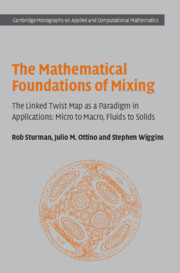 The Mathematical Foundations of Mixing
The Mathematical Foundations of Mixing Book contents
- Frontmatter
- Contents
- Preface
- Acknowledgments
- 1 Mixing: physical issues
- 2 Linked twist maps: definition, construction and the relevance to mixing
- 3 The ergodic hierarchy
- 4 Existence of a horseshoe for the linked twist map
- 5 Hyperbolicity
- 6 The ergodic partition for toral linked twist maps
- 7 Ergodicity and the Bernoulli property for toral linked twist maps
- 8 Linked twist maps on the plane
- 9 Further directions and open problems
- References
- Index
Preface
Published online by Cambridge University Press: 03 February 2010
- Frontmatter
- Contents
- Preface
- Acknowledgments
- 1 Mixing: physical issues
- 2 Linked twist maps: definition, construction and the relevance to mixing
- 3 The ergodic hierarchy
- 4 Existence of a horseshoe for the linked twist map
- 5 Hyperbolicity
- 6 The ergodic partition for toral linked twist maps
- 7 Ergodicity and the Bernoulli property for toral linked twist maps
- 8 Linked twist maps on the plane
- 9 Further directions and open problems
- References
- Index
Summary
Where is mixing important?
Mixing processes occur in a variety of technological and natural applications, with length and time scales ranging from the very small (as in microfluidic applications), to the very large (mixing in the Earth's oceans and atmosphere). The spectrum is quite broad; the ratio of the contributions of inertial forces (dominant in the realm of the very large) to viscous forces (dominant on the side of the very small) spans more than twenty orders of magnitude.
Theoretical and experimental developments over the last two decades have provided a strong foundation for the subject, yet much remains to be done. Earlier work focused on mixing of liquids and considerable advances have been made. The basic theory can be extended in many directions and the picture has been augmented in various ways. One strand of the expansion has been an incursion into new applications such as oceanography, geophysics and applications to the design of new mixing devices, as in microfluidics. Asecond strand is incursion into new types of physical situations, such as mixing of dry granular systems and liquid granular systems (in which air is replaced by a liquid). These applications clearly put us on a different plane – new physics – since, in contrast to mixing of liquids, a complicating factor in the flow of granular material is the tendency for materials to segregate or demix as a result of differences in particle properties, such as density, size, or shape. Mixing competes with segregation: mixtures of particles with varying size (S-systems) or varying density (D-systems) often segregate leading to what, on first viewing, appear to be baffling results.
- Type
- Chapter
- Information
- The Mathematical Foundations of MixingThe Linked Twist Map as a Paradigm in Applications: Micro to Macro, Fluids to Solids, pp. xiii - xixPublisher: Cambridge University PressPrint publication year: 2006


